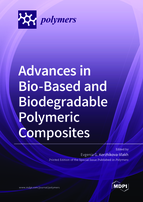Advances in Bio-Based and Biodegradable Polymeric Composites
A special issue of Polymers (ISSN 2073-4360). This special issue belongs to the section "Polymer Composites and Nanocomposites".
Deadline for manuscript submissions: closed (30 June 2022) | Viewed by 82497
Special Issue Editor
2. Institute of Chemistry, Saint-Petersburg State University, Universitetsky pr. 26, 198504 St. Petersburg, Russia
Interests: amphiphilic polymers; self-assembling; nanoparticles; biodegradation; drug delivery systems; proteins; peptides; DNA/RNA
Special Issues, Collections and Topics in MDPI journals
Special Issue Information
Dear Colleagues,
In recent years, the emergence of new environmental standards and the need for modern effective biodegradable medical materials have led to the development of new green and biodegradable polymer composites. Bio-based and biodegradable polymers have great potential and a number of advantages for the production of eco-friendly and biomedical materials. However, further development and application of such materials require their improvement. Modification of polymers with functional fillers and reinforcing agents can significantly alter the mechanical and physico-chemical characteristics, as well as the biological properties of the polymer material. The combination of bio-based and biodegradable polymers with fillers/reinforcements of various chemistry, dimension, and geometry can lead to a higher level of diversity provided by composite materials as compared to just polymeric ones.
The aim of this Special Issue is to overview and discuss current progress in terms of science and technology of bio-based and biodegradable polymeric composites. Topics of interest include all aspects of the manufacturing, characterization and application of such composites, as well as theoretical studies in the field.
Dr. Evgenia Korzhikova-Vlakh
Guest Editor
Manuscript Submission Information
Manuscripts should be submitted online at www.mdpi.com by registering and logging in to this website. Once you are registered, click here to go to the submission form. Manuscripts can be submitted until the deadline. All submissions that pass pre-check are peer-reviewed. Accepted papers will be published continuously in the journal (as soon as accepted) and will be listed together on the special issue website. Research articles, review articles as well as short communications are invited. For planned papers, a title and short abstract (about 100 words) can be sent to the Editorial Office for announcement on this website.
Submitted manuscripts should not have been published previously, nor be under consideration for publication elsewhere (except conference proceedings papers). All manuscripts are thoroughly refereed through a single-blind peer-review process. A guide for authors and other relevant information for submission of manuscripts is available on the Instructions for Authors page. Polymers is an international peer-reviewed open access semimonthly journal published by MDPI.
Please visit the Instructions for Authors page before submitting a manuscript. The Article Processing Charge (APC) for publication in this open access journal is 2700 CHF (Swiss Francs). Submitted papers should be well formatted and use good English. Authors may use MDPI's English editing service prior to publication or during author revisions.
Keywords
- bio-based polymers
- biodegradable polymers
- composite blends
- composite membranes
- 3D-composites
- nanocomposite fibers
- nanocomposite foams
- organic polymer composites
- polymer-inorganic composites
- biocomposites
- multifunctional composites
- design and manufacturing
- mechanical properties
- physico-chemical characterization
- biological properties







